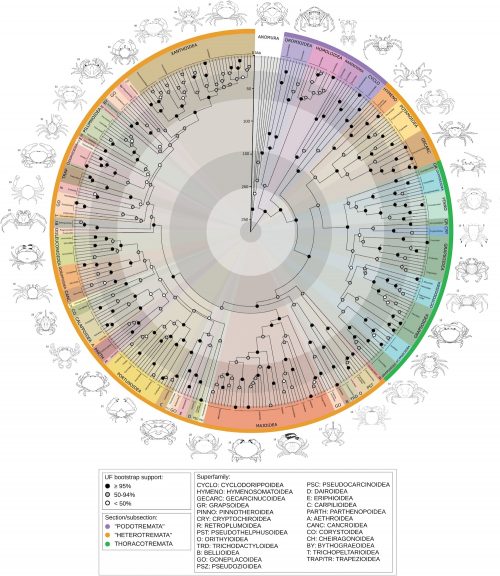This diagram from Convergent Adaptation of True Crabs (Decapoda: Brachyura) to a Gradient of Terrestrial Environments is going to reinforce the idea that everything converges on crabs…which is kind of cool anyway.

Summary of phylogeny and divergence time estimates for Brachyura (88 brachyuran families, 263 genera, 333 species, 338 individuals plus 6 outgroups). Posterior ages were estimated in BEAST2 using a fixed topology resulting from the concatenated ML analysis in IQ-TREE, 36 vetted node calibrations, a birth–death tree prior, and relaxed lognormal clock model. Shaded circles at nodes represent ultrafast bootstraps. Pie slices are colored by superfamily, with the outermost ring colored by taxonomic section. Line drawings, one representative per superfamily (numbers corresponding to taxa in Supplementary Table S7), by Javier Luque and Harrison Mancke.
Please note, this diagram illustrates the evolution of a single, large, successful clade, the Brachyura. It does not imply that humans and salamanders and spiders are going to converge on a crablike form, OK? The interesting thing is that all the descendants of this Triassic lineage, despite going through multiple independent transitions from marine to terrestrial and back again, have assumed these very similar (superficially, at least) forms, and that tells us something interesting. The Brachyura have some internal constraints that shape their evolution, and studying them help us understand the balance between inherited patterns and external forces. That’s the conclusion of the paper, that there are constraints on evolution.
Herein, we inferred a large molecular phylogeny of true crabs, estimated divergence times that were older than previously thought, and estimated the number of transitions from marine to non-marine lifestyles. We found up to 17 convergent transitions through direct and indirect pathways, with at least 3 climbing to higher degrees of terrestrial adaptation. The most highly terrestrial clades were some of the oldest non-marine inferences in our data, with their common ancestors having diverged over 66 Ma. At least 9 more recent events throughout the Cenozoic led to crabs living in intertidal and marginal marine environments, a shift that is estimated to be much easier based on lower threshold liability and likely fewer traits required. As instances of convergent evolution provide emerging models in the form of “natural experiments,” the framework we have developed to compare the gradient of adaptations will enable future research that aims to “predict” the constraints leading to repeated trait evolution and better understand the drivers of biodiversity across related groups.


If I read that tree correctly, it also implies that a major revision of crab taxonomy is needed, as several superfamilies seem to be paraphyletic or polyphyletic.
Now that “carcinozation” meme makes sense. Sounds like the whole thing is happening not because the crab-form is playing evolution’s metagame, but just a consequence of legacy limitations that are hard to get over.
@2 Recursive Rabbit
No. The “cacinozation” meme refers to the convergence towards a crab-like bauplan of many different groups within Decapoda.
This is about a single one of these groups, the true crabs, convergently adapting to freshwater or terrestrial environments.
PZ says:
I beg to differ:
https://youtu.be/vdEco8OCiS8?si=ljE9sLTGID3LQcwb
Some of the convergences in the paper seem more physiological like osmoregulation, or developmental like larval stuff. The minor body plan stuff such as “branchiostegal lungs” and “water-wicking setae” are interesting though they are still crabs overall. No larger scale “cacinozation” involved then. I guess no matter the degree of terrestialization water is still important for reproduction?
Why do Google searches now add in the intratextual parts? https://nationalzoo.si.edu/animals/land-hermit-crab#:~:text=Reproduction%20and%20Development,their%20stomachs%20together%20to%20mate. Leaving it in.
The fact remains: “Hermit crabs mate in seawater.” Oh I see hermit crabs are not true crabs according to wikipedia. Oh well.
But to the degree parallelism or convergence occurs on smaller scales in this paper or larger scales across higher situated taxa (cacinozation?), this repeatability of evolution as natural experiment causes problems for Gouldian contingency too, no? Replaying the diachronically temporal tape is not far off from convergently almost synchronic outcomes perhaps? I had read a bit on this a while back and may not be recalling the problem perfectly. One of those backburner topics.
So no flying crabs. Go ahead, ruin my dreams. ;)
Speaking of crabs….’Feeling Crabby’
Crabs all the way down.
What I disliked about this news item going around some time ago how “crabs” have evolved several times on Earth, is that it muddles the concepts of parallel and convergent evolution. I know the distinction is hard to draw to the extent that some experts don’t even want to make it, but a lot of these para-crabs had very similar evolutionary starting point to begin with, so it isn’t exactly surprising you can get similar outcomes multiple times.
If my descendants aren’t going to have claws and exoskeletons, what even is the point of procreation? Sorry, JD Vance, but I’m out.